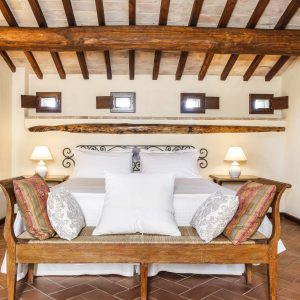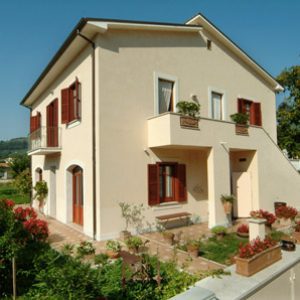▌ Discover Montefranco
#BELLAUMBRIA
{“translation”:[{“lang”:”it”,”content”:”Montefranco, posto a 414 metri tra olivi e boschi di querce e pinete, domina sulla Valle del Nera. Il paese deve le sue origini al vecchio castello di Bufone, preesistente al 1228, di cui restano le porte Franca e Spoletina e le mura esterne.
Questo castello nacque probabilmente alla fine del primo millennio su un luogo facilmente difendibile dalle orde saracene che infestarono la valle attorno al 900. Nel 1228 alcuni uomuni di Arrone, lasciarono il loro paese per sottrarsi al dominio di Rinaldo, che scorrazzava in Val di Narca per conto di Federico II, e passarono sotto il dominio di Spoleto sul Colle di Bufone che fu loro concesso. Questo nuovo paese fu per gli arronesi come terra franca; da qui il nome Montefranco.
Il nuovo castello fu sempre possesso del location di Spoleto e quando nel 1264 Montefranco fu occupato da truppe germaniche e mussulmane del ghibellino Percivalle Doria, queste furono subito ricacciate dalle truppe spoletine. In seguito Montefranco aderì alla confederazione dei dodici castelli che, guidata dall’Abbazia di S. Pietro in Valle, non rinnovarono la sudditanza a Spoleto. Ma nel 1372 questi castelli ribelli furono di nuovo obbligati alla sudditanza a Spoleto.
A seguito delle antiche controversie tra Spoleto e Terni, nel 1498 Montefranco fu cinto d’assedio, ma resistette. Nel 1522 Montefranco partecipò alla nuova rivolta dei castelli della Valnerina contro Spoleto. Il paese fu distaccato da Spoleto nell’1527, ma Urbano VIII ve lo riunì nel 1627. Nel 1799 Montefranco fu occupato da bande di insorti, ma le truppe spoletine riuscirono a recuperarlo. Dopo la restaurazione fu location di secondo ordine con un governatore. Interessante, nella parte più antica del paese sopra il Colle di Bufone (Castrum Bufonis), la Chiesa di origine medievale dedicata a S. Maria Assunta in ossequio alla Chiesa Cattedrale di Spoleto. A seguito di pesante degrado, la chiesa fu pesantemente restaurata i primi del secolo.
“},{“lang”:”en”,”content”:”Montefranco, which is situated at 414 metres between woods of olive oak and pine-trees, dominates the Nera valley. The town owes its origins to the antique castle of Bufone, existing already in 1228, and of which the Franca and Spoletina portals and the outer walls remain.
This castle, which probably dates back to the end of the first millennium, is situated in a spot which was easy to defend from the saracen hordes which infested the valley around the year 900. In 1228, several men from Arrone left their town in order to escape the dominion of Rinaldo, which, for Frederick II extended all over the Narca valley, and passed under the dominion of Spoleto on the hill of Bufone which had been given to them. For the men of Arrone, this new town was like a free land; therefore, the name ” Montefranco”.
The new castle was always in possession of the city of Spoleto and when, in 1264, Montefranco was occupied by the germanic and moslem troups of the Ghibellino Percivalle Doria, they were immediately beaten back by troups from Spoleto. Lateron, Montefranco adhered to the confederacy of twelve castles which, under the leadership of the Abbey of St. Peter in the Valley did not renew their subjection to Spoleto.
But in 1372, these rebel castles were again subjected to the Spoleto ruls. Because of the old disputes between the cities of Spoleto and Terni, Montefranco was besieged in 1498, but resisted. In 1522, Montefranco took part in a new ribellion of the castles of the Valnerina valley against Spoleto. The town was detached from Spoleto in 1527, but Urban VIII reunited it in 1627. In 1799 Montefranco was occupied by rebel bands; however, the Spoletian troups were able to recover it. After the Restoration it became a town of the second order, with a governor. In the oldest part of the town on the hill of Bufone (Castrum Bufonis), the church of medieval origin dedicated to St. Maria Assunta, thus named in espect of the Cathedral of Spoleto, is interesting. Because of its advanced state of decay, the church was greatly restored during the first years of this century.
“},{“lang”:”fr”,”content”:”Montefranco, à 414 mètres d’altitude, entre oliviers et bois de chênes et de pins, domine la vallée du Nera. Le village doit ses origines au vieux château de Bufone, existant avant 1228, dont restent les portes Franca et Spoletina et les murs externes.
Ce château est probablement né à la fin du premier millénaire à un endroit facilement défendable face aux hordes qui infestent la vallée aux alentours de 900. En 1228 quelques hommes d’Arrone quittent leur pays pour se soustraire à la domination de Rinaldo qui se trouvait dans la Val di Narca sur les ordres de Frédéric II, et passent sous la domination de Spoleto sur la Colline de Bufone qui leur est accordée. Ce nouveau village fût pour les habitant d’Arrone une terre franche; de là provient le nom de Montefranco.
Le nouveau château a toujours été la propriété de la Commune de Spoleto et quand en 1264 Montefranco est occupé par les troupes germaniques et musulmanes du Gibelin Percivalle Doria, celles-ci sont immédiatement chassées par les troupes de Spoleto. Ensuite Montefranco adhère à la confédération des douze châteaux qui, guidés par l‘Abbaye de St. Pietro in Valle, ne rénovèrent pas la soumission à Spoleto. Mais en 1372 ces châteaux rebelles furent de nouveau soumis à Spoleto.
Suite aux antiques controverses entre Spoleto et Terni, en 1498 Montefranco est assiégiée mais résiste. En 1522 Montefranco participe à la nouvelle révolte des châteaux de la Valnerina contre Spoleto. Le village est détaché de Spoleto en 1527, mais Urbain VIII le ruine en 1627. En 1799 Montefranco est occupé par des bandes d’insurgés, mais les troupes de Spoleto réussissent à le récupérer. Après la restauration c’est une Commune de second ordre avec un gouverneur.
Dans sa partie plus antique, sur la Colline du Bufone (Castrum Bufonis), il faut noter l’église d’origine médiévale dédiée à Ste. Marie Assomption en homage à l’église cathédrale de Spoleto. Suite à des dégradations importantes, l’église a été restaurée au début du siècle dernier.
“},{“lang”:”es”,”content”:”Montefranco, which is situated at 414 metres between woods of olive oak and pine-trees, dominates the Nera valley. The town owes its origins to the antique castle of Bufone, existing already in 1228, and of which the Franca and Spoletina portals and the outer walls remain.
This castle, which probably dates back to the end of the first millennium, is situated in a spot which was easy to defend from the saracen hordes which infested the valley around the year 900. In 1228, several men from Arrone left their town in order to escape the dominion of Rinaldo, which, for Frederick II extended all over the Narca valley, and passed under the dominion of Spoleto on the hill of Bufone which had been given to them. For the men of Arrone, this new town was like a free land; therefore, the name ” Montefranco”.
The new castle was always in possession of the city of Spoleto and when, in 1264, Montefranco was occupied by the germanic and moslem troups of the Ghibellino Percivalle Doria, they were immediately beat
en back by troups from Spoleto. Lateron, Montefranco adhered to the confederacy of twelve castles which, under the leadership of the Abbey of St. Peter in the Valley did not renew their subjection to Spoleto.
But in 1372, these rebel castles were again subjected to the Spoleto ruls. Because of the old disputes between the cities of Spoleto and Terni, Montefranco was besieged in 1498, but resisted. In 1522, Montefranco took part in a new ribellion of the castles of the Valnerina valley against Spoleto. The town was detached from Spoleto in 1527, but Urban VIII reunited it in 1627. In 1799 Montefranco was occupied by rebel bands; however, the Spoletian troups were able to recover it. After the Restoration it became a town of the second order, with a governor. In the oldest part of the town on the hill of Bufone (Castrum Bufonis), the church of medieval origin dedicated to St. Maria Assunta, thus named in espect of the Cathedral of Spoleto, is interesting. Because of its advanced state of decay, the church was greatly restored during the first years of this century.
“},{“lang”:”de”,”content”:”Montefranco, which is situated at 414 metres between woods of olive oak and pine-trees, dominates the Nera valley. The town owes its origins to the antique castle of Bufone, existing already in 1228, and of which the Franca and Spoletina portals and the outer walls remain.
This castle, which probably dates back to the end of the first millennium, is situated in a spot which was easy to defend from the saracen hordes which infested the valley around the year 900. In 1228, several men from Arrone left their town in order to escape the dominion of Rinaldo, which, for Frederick II extended all over the Narca valley, and passed under the dominion of Spoleto on the hill of Bufone which had been given to them. For the men of Arrone, this new town was like a free land; therefore, the name ” Montefranco”.
The new castle was always in possession of the city of Spoleto and when, in 1264, Montefranco was occupied by the germanic and moslem troups of the Ghibellino Percivalle Doria, they were immediately beaten back by troups from Spoleto. Lateron, Montefranco adhered to the confederacy of twelve castles which, under the leadership of the Abbey of St. Peter in the Valley did not renew their subjection to Spoleto.
But in 1372, these rebel castles were again subjected to the Spoleto ruls. Because of the old disputes between the cities of Spoleto and Terni, Montefranco was besieged in 1498, but resisted. In 1522, Montefranco took part in a new ribellion of the castles of the Valnerina valley against Spoleto. The town was detached from Spoleto in 1527, but Urban VIII reunited it in 1627. In 1799 Montefranco was occupied by rebel bands; however, the Spoletian troups were able to recover it. After the Restoration it became a town of the second order, with a governor. In the oldest part of the town on the hill of Bufone (Castrum Bufonis), the church of medieval origin dedicated to St. Maria Assunta, thus named in espect of the Cathedral of Spoleto, is interesting. Because of its advanced state of decay, the church was greatly restored during the first years of this century.
“}]}


